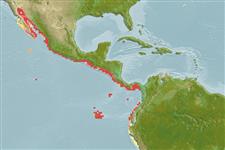Environment: milieu / climate zone / rango de profundidad / distribution range
Ecología
marino demersal; rango de profundidad 46 - 90 m (Ref. 9342). Subtropical; 33°N - 10°S, 116°W - 78°W (Ref. 5222)
Eastern Pacific: southern California in the USA, south to Peru.
Tamaño / Peso / Age
Madurez: Lm ? range ? - ? cm
Max length : 100.0 cm TL macho / no sexado; (Ref. 5222)
Espinas dorsales (total) : 11; Radios blandos dorsales (total) : 16 - 18; Espinas anales: 3; Radios blandos anales: 8. Distinguished by the following characteristics: dark red or brown head and body; darker pectoral fins than body; tips of interspinous dorsal fin membranes darker than the rest of the membranes; prominent black moustache streak occurs above maxilla; depth of body contained 2.4-2.6 times in SL; head length 2.3-2.4 times in SL; convex interorbital area; rounded preopercle, finely serrate, enlarged serrae at angle but covered by skin; distinctly convex upper edge of operculum (Ref. 89707).
Body shape (shape guide): fusiform / normal; Cross section: compressed.
Common in the Gulf of California. Occasionally encountered in isolated reefs and sandy bottoms near the coast at depths of 46 to 90 m; uncommon in shallow waters (Ref. 89707).
Life cycle and mating behavior
Madurez | Reproducción | Puesta | Huevos | Fecundidad | Larva
Craig, M.T. and P.A. Hastings, 2007. A molecular phylogeny of the groupers of the subfamily Epinephelinae (Serranidae) with revised classification of the epinephelini. Ichthyol. Res. 54:1-17. (Ref. 83414)
IUCN Red List Status (Ref. 130435: Version 2025-1)
Threat to humans
Harmless
Human uses
Pesquerías: escaso valor comercial
Herramientas
Special reports
Download XML
Fuentes de Internet
Estimates based on models
Preferred temperature (Referencia
123201): 17 - 26, mean 19.9 °C (based on 16 cells).
Phylogenetic diversity index (Referencia
82804): PD
50 = 0.5000 [Uniqueness, from 0.5 = low to 2.0 = high].
Bayesian length-weight: a=0.01072 (0.00607 - 0.01892), b=3.03 (2.88 - 3.18), in cm total length, based on LWR estimates for this species & Genus-body shape (Ref.
93245).
Nivel trófico (Referencia
69278): 3.9 ±0.7 se; based on size and trophs of closest relatives
Resiliencia (Referencia
120179): Muy bajo, población duplicada en un tiempo mínimo superior a 14 años (Preliminary K or Fecundity.).
Fishing Vulnerability (Ref.
59153): High vulnerability (60 of 100).
🛈
Nutrients (Ref.
124155): Calcium = 39.8 [16.6, 82.2] mg/100g; Iron = 0.73 [0.39, 1.41] mg/100g; Protein = 18.9 [17.0, 20.6] %; Omega3 = 0.353 [0.211, 0.601] g/100g; Selenium = 30.9 [14.9, 65.2] μg/100g; VitaminA = 12.5 [3.6, 49.6] μg/100g; Zinc = 0.516 [0.363, 0.769] mg/100g (wet weight);
